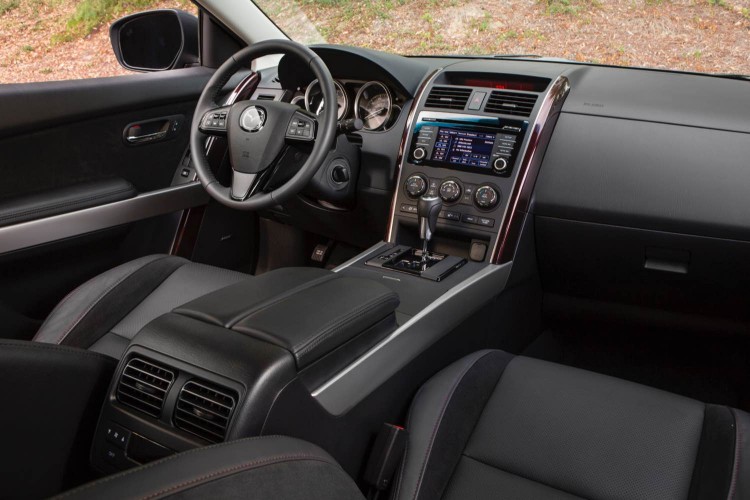When Mazda first launched its flagship crossover utility, dubbed CX-9, it took what was then a radical approach to designing CUVs by adding, of all things, a third row. This quickly helped the CX-9 garner such high honors as North American Truck/Utility of the Year and Motor Trend Sport Utility of the Year and has helped it remain popular today.
The CX-9 was co-developed alongside the Ford Edge and Lincoln MKX (then partners under the Big Blue Oval) but Mazda adds that child-only third row to the platform for a more competitive “edge” in what has been one of the hottest segments in the marketplace. An instant success when it first hit the market in 2007, the CX-9 raised the bar for three-row crossover SUVs.
Mazda used targets of the Honda Pilot and Volkswagen Touareg as they set out to develop a functional yet emotional CUV that comes in under the luxury segment. What it delivers is a unibody chassis offered in front- and all-wheel-drive that is powered by Ford-sourced global 3.7-liter V-6 engine but backed by a model-exclusive Aisin six-speed Sport AT automatic transmission, and Mazda also uses a different AWD system than its domestic siblings.
The Active Torque Split AWD system employed in the CX-9 is a derivative of the system used in the discontinued smaller CX-7 CUV. It is always active and can achieve up to a 50/50 torque split front to rear when sensors dictate.
While our recent 2015 tester arrived in the Grand Touring FWD format, we found the AWD setup to be quite transparent in operation during a day of ambitious driving in the hills north of LA at the model launch nearly a decade ago. We knew we were pushing the CX-9 pretty hard but never felt we had reached the limits of what we could throw at the vehicle (save for our unsecured bags sliding around the back seat area).
Drivers and occupants can take comfort in the fact that the big Mazda offers one of the most complete lineups of safety technology including Roll Stability Control, Dynamic Stability Control, traction control, ABS and electronic brakeforce distribution as well as a host of front, side and side curtain airbags. We really appreciate Blind Spot Monitoring system as well as Rear Cross Traffic Alert and the rear backup sensors and rearview camera.
The 273 ponies under the hood never found us lacking for inspiration and we were thoroughly impressed by the smooth six-speed automatic gearbox. A manual sport mode is available but we find ourselves really only asking “why” as normal mode delivered everything we needed in the mixed driving conditions.
Mazda gave the CX-9 a much needed makeover in 2013 updating styling to its sigature KODO “Soul of Motion” design language. It also upgraded the technology to keep its big crossover competitive in the marketplace.
CX-9 is offered in Sport, Touring and Grand Touring trim levels with up to 20-inch wheels and tires available. Our Grand Touring model was loaded to the gills and included the Tech Package (including Bose premium audio system and color touch screen Navigation) as well as the new Towing Prep Package (with a tow capacity of 3,500 lbs.) and the Recreational Accessory Package.
Pricing for the Grand Touring FWD model begins at $35,035 with this loaded tester arriving with a final sticker of $38,400. Fuel economy is rated at 17 mpg city and 24 mpg highway.
The vehicle is extremely quiet and well-mannered on the road. About the only vibration we detected was from the tires and road surfaces. The only criticism I really have of the vehicle is the heft of the center console that takes away from the driver’s lateral knee room (and right elbow room) a bit.
The Mazda CX-9 continues to be the winner it started out as – first impressions were correct here. Mazda aimed for a “fun to drive, family-capable” target with the CX-9. They hit the bullseye with this one and that continues to be the story today.





